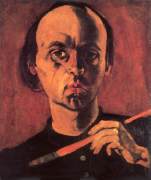ILOSVAI VARGA, István
(1895, Kunhegyes - 1978, Szentendre)


Painter artist, a leading personage of the Szentendre school of painting. Merited Artist (1968), Eminent Artist (1974). Originally a law-student he attended evening classes at the School of Industrial Drawing in his free time, then he attended the Independent School of Károly Kernstok in 1917. He studied at the Academy of Fine Arts as a student of Endre Balló in 1917-1922. He made a study-trip to Paris in 1924-25. His artworks of this time reflect the influence of Van Gogh, Gauguin and Cézanne. He would visit the Colony of Artists at Nagybánya (Baia Mare, Romania) in 1929-31. His Fauveish canvasses made here testify to attempts at the application of new styles. He developed his real painter's self in Szentendre, where he would paint initially in the summers from 1932 onward, then he would settle for good in this town in 1935. He became a member of the New Artist Union in 1935, the New Society of Artists in 1936 and the Society of Szentendre Painters in 1941.
It was in Szentendre that he stumbled upon the poetic and yet carefully engineered spatial construction inherent in the townscape that his painter's perception had been looking for. The ensemble of mall town spaces, streets, house walls and people became the sole themes of his pictures. In the thirties he would depict everyday life in anecdotal scenes or inspired by social sentiments (Three Workers, Poor Man). In the forties, the presence of the human aspect was represented by silhouette figures scraped on the canvas or drawn in a marked contour (Black Picture). In the middle of that decade an expressive set of markedly drawn lines indicating the emphatic structural units would appear for a brief period (Constructive Self-portrait). His colour scheme became brighter from the fifties. The dark-deep toned earth colours and deep reds of earlier decades gradually diluted. Temporarily, he made street views and still-lifes of traditional perspectives in the fifties (Well-pump). From the following decade onward not only his colours became even brighter, but also he produced spatial constructions of daring design. The balance achieved between constructed space and consistent colourism has rendered uniformity to his oeuvre.
His legacy is now in the possession of the Directorate of the Museums of Pest County, but the Hungarian National Gallery and his birth-town, Kunhegyes also own a significant collection of his works.
